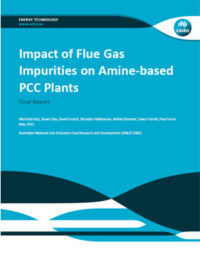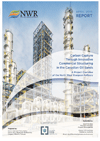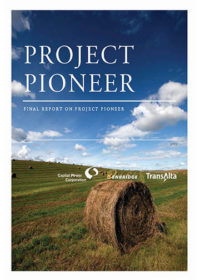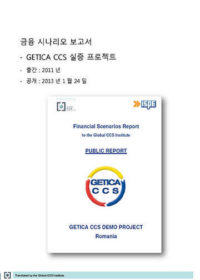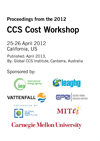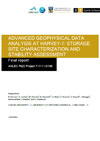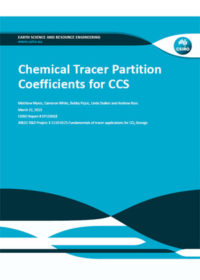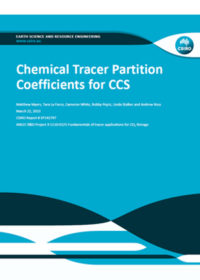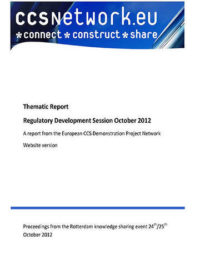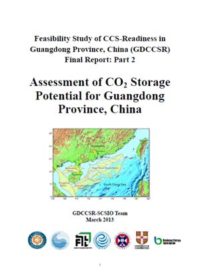Resources
Publications
Our publications, reports and research library hosts over 500 specialist reports and research papers on all topics associated with CCS.
View our Publication Library Disclaimer.
Filter by
Impact of flue gas impurities on amine-based PCC plants
1st May 2013
Topic(s): Carbon capture use and storage (CCUS), CO2 capture
Disclaimer
The content within the Global CCS Institute Publications, Reports and Research Library is provided for information purposes only. We make every effort and take reasonable care to keep the content of this section up-to-date and error-free. However, we make no claim as to its accuracy, currency or reliability.
Content and material featured within this section of our website includes reports and research published by third parties. The content and material may include opinions and recommendations of third parties that do not reflect those held by the Global CCS Institute.
Carbon capture through innovative commercial structuring in the Canadian oil sands: a project overview of the North West Sturgeon Refinery
29th April 2013
Topic(s): Carbon capture use and storage (CCUS), CO2 utilisation
The fully integrated project will capture, use for EOR and geologically sequester over 1.2 million tonnes per year of 99% pure, dry CO2, the equivalent to removing approximately 225,000 vehicles from the road. The CO2 from the NWSR will also be the anchor supply for the Alberta Carbon Trunk Line (ACTL), an open access CO2 pipeline being developed by Enhance Energy Inc. The ACTL has public funding which will support the development of a common CO2 handling infrastructure for EOR in Alberta.
The willingness of the Alberta and Canadian governments to support large scale CCS projects with the creation of a CCS Fund and development of an effective CO2 storage regulatory framework was essential for the CO2 capture component of the NWRP and ACTL to proceed.
Disclaimer
The content within the Global CCS Institute Publications, Reports and Research Library is provided for information purposes only. We make every effort and take reasonable care to keep the content of this section up-to-date and error-free. However, we make no claim as to its accuracy, currency or reliability.
Content and material featured within this section of our website includes reports and research published by third parties. The content and material may include opinions and recommendations of third parties that do not reflect those held by the Global CCS Institute.
Project Pioneer: final report on Project Pioneer
29th April 2013
Topic(s): Business cases, Carbon capture use and storage (CCUS), Project financing
After completion of a feasibility study and despite substantial government and industry investment, the Project was not economically feasible due to insufficient CO2 sales markets and emissions pricing in Alberta and Canada.
Disclaimer
The content within the Global CCS Institute Publications, Reports and Research Library is provided for information purposes only. We make every effort and take reasonable care to keep the content of this section up-to-date and error-free. However, we make no claim as to its accuracy, currency or reliability.
Content and material featured within this section of our website includes reports and research published by third parties. The content and material may include opinions and recommendations of third parties that do not reflect those held by the Global CCS Institute.
금융 시나리오 보고서 – GETICA CCS 실증 프로젝트
11th April 2013
Topic(s): Carbon capture use and storage (CCUS), Project financing
루마니아의 전력 발전은 주로 석탄에 의존하고 있기 때문에, CCS를 사용하면 화력발전소를 계속 가동하면서CO2 배출량을 크게 감소시킬 수 있다.
이 금융 시나리오 보고서는 대규모 CCS 프로젝트를 위한 최적의 해법을 분석하고 있는데, 이 프로젝트를 위한 재무 자원을 찾고 확보하는 문제를 다루고 있다.
현재 확보한 자금원은 유럽연합 및 국가 차원의 자금이며, 프로젝트 금융 구조의 적합성, 프로젝트의 자격, 자금의 출처(공공/민간), 자금의 유효성, 시간의 유효성과 확신의 정도를 분석하였다.
세 개의 시나리오는 CCS 프로젝트를 위한 자금원의 가능성을 기반으로 완성되었다. 질적 평가가 실시되었으며, 이 평가를 바탕으로 최고의 시나리오가 선정되었다.
제안된 금융 시나리오는 NER 300보조금과 유럽연합의 배출권 거래 제도(EU ETS)의 경매 소득에 근거하였다. 투자비를 충당할 수 있는 그 외 다른 자금원은 소규모의 보조금들과 주식 발행, 그리고 대출이다. 이 시나리오는 가장 성공 가능성이 높은 자금원들을 조합한 것이며, Getica 프로젝트가 진행되는 동안 실행 비용 및 운영, 금융 비용이 충당될 것이다.
Disclaimer
The content within the Global CCS Institute Publications, Reports and Research Library is provided for information purposes only. We make every effort and take reasonable care to keep the content of this section up-to-date and error-free. However, we make no claim as to its accuracy, currency or reliability.
Content and material featured within this section of our website includes reports and research published by third parties. The content and material may include opinions and recommendations of third parties that do not reflect those held by the Global CCS Institute.
Proceedings from the 2012 CCS cost workshop: 25-26 April 2012, California, US
1st April 2013
Topic(s): Carbon capture use and storage (CCUS), Economics, Public engagement
The third meeting of the Expert Group on CCS costs was held on April 25-26 2013 and hosted by the Electric Power Research Institute in Palo Alto. The current understanding of the costs of CCS was presented at that meeting and the agreed outcomes for the Group to take forward are included in this document.
This work program consists of efforts to improve both the transparency of CCS cost calculations and the broader challenges associated with conveying messages around costs to the broader community.
The meeting focused on a number of issues including considering guidelines and recommendations developed by a Task Group for a costing method and nomenclature that could be broadly adopted to produce more consistent and transparent cost estimates for CCS applied to electric power plants; along with how to evaluate emerging process as well as transport, storage and utilization.
Topics discussed over the two days included:
- What are the main reasons for the reported costs of CCS demonstrations being significantly higher than the numbers in published CCS cost studies?
- What information would be useful to have from demonstration projects to help improve the published cost estimates?
- Should transport and storage form part of the work program to harmonize cost methods and nomenclature? And if so, what cost elements can be harmonized?
- How should ‘enhanced oil recovery’ storage operations be incorporated in harmonization efforts for storage? Alternatively, do the cost categories vary compared to saline formations?
- What types of methodologies are used to estimate costs for emerging processes?
- What kind of information should be reported in order to understand ‘what lies behind’ economic evaluations of emerging processes?
- How is the mix of commercially proven and modifications to commercially proven technologies best handled in terms of estimating equipment costs?
- How can uncertainties and risks be assessed in relation to estimated costs?
Disclaimer
The content within the Global CCS Institute Publications, Reports and Research Library is provided for information purposes only. We make every effort and take reasonable care to keep the content of this section up-to-date and error-free. However, we make no claim as to its accuracy, currency or reliability.
Content and material featured within this section of our website includes reports and research published by third parties. The content and material may include opinions and recommendations of third parties that do not reflect those held by the Global CCS Institute.
Advanced geophysical data analysis at Harvey-1: storage site characterization and stability assessment. Final report
25th March 2013
Topic(s): Carbon capture use and storage (CCUS), CO2 storage
One of the first planned onshore commercial-scale CO2 geosequestration projects in Australia is at the South West Hub site, approximately 150 km south of Perth, WA. As part of the detailed characterisation work at the site, the new Harvey-1 Data Well was drilled in early 2012 to approximately 3km depth, penetrating the Lower Lesueur formation which is the main CO2 injection target. Its purpose was to obtain rock core samples and other physical data to reduce gaps in geological knowledge and help assess the suitability of the formation for CO2 storage. Drilling of the Harvey-1 Data Well has provided several geophysical data sets, including log data and zero-offset vertical seismic profiling (ZVSP) data. In addition, a set of 2D seismic lines was acquired in 2011, with basic image processing performed by a contractor. The main goal of this ANLEC research project is to apply a range of advanced data analysis techniques, developed by (or available to) WA:ERA researchers, to the geophysical datasets acquired at the Harvey-1 data well and the recently acquired 2D seismic data, in order to extract higher value from the data, reduce risk in the SW Hub CCS project through improved storage site characterisation, and guide optimal acquisition and processing parameters for future geophysical surveys.
Disclaimer
The content within the Global CCS Institute Publications, Reports and Research Library is provided for information purposes only. We make every effort and take reasonable care to keep the content of this section up-to-date and error-free. However, we make no claim as to its accuracy, currency or reliability.
Content and material featured within this section of our website includes reports and research published by third parties. The content and material may include opinions and recommendations of third parties that do not reflect those held by the Global CCS Institute.
Chemical tracer partition coefficients for CCS
22nd March 2013
Topic(s): Carbon capture use and storage (CCUS), CO2 storage
Disclaimer
The content within the Global CCS Institute Publications, Reports and Research Library is provided for information purposes only. We make every effort and take reasonable care to keep the content of this section up-to-date and error-free. However, we make no claim as to its accuracy, currency or reliability.
Content and material featured within this section of our website includes reports and research published by third parties. The content and material may include opinions and recommendations of third parties that do not reflect those held by the Global CCS Institute.
Chemical tracer partition coefficients for CCS
22nd March 2013
Topic(s): Carbon capture use and storage (CCUS), CO2 storage
This project studies the use of chemical tracers to track the migration of CO2 once it’s injected underground and to monitor the containment security. Once injected, tracers partition between the CO2 and the other fluids present in the system. Supercritical CO2/water partition coefficients are established for a number of chemical tracers relevant to CCS. This study will improve estimates and correlations for characterising reservoir capacity.
Disclaimer
The content within the Global CCS Institute Publications, Reports and Research Library is provided for information purposes only. We make every effort and take reasonable care to keep the content of this section up-to-date and error-free. However, we make no claim as to its accuracy, currency or reliability.
Content and material featured within this section of our website includes reports and research published by third parties. The content and material may include opinions and recommendations of third parties that do not reflect those held by the Global CCS Institute.
Disclaimer
The content within the Global CCS Institute Publications, Reports and Research Library is provided for information purposes only. We make every effort and take reasonable care to keep the content of this section up-to-date and error-free. However, we make no claim as to its accuracy, currency or reliability.
Content and material featured within this section of our website includes reports and research published by third parties. The content and material may include opinions and recommendations of third parties that do not reflect those held by the Global CCS Institute.
Qualification criteria for the European CCS Network
15th March 2013
Topic(s): Carbon capture use and storage (CCUS)
Disclaimer
The content within the Global CCS Institute Publications, Reports and Research Library is provided for information purposes only. We make every effort and take reasonable care to keep the content of this section up-to-date and error-free. However, we make no claim as to its accuracy, currency or reliability.
Content and material featured within this section of our website includes reports and research published by third parties. The content and material may include opinions and recommendations of third parties that do not reflect those held by the Global CCS Institute.
Thematic report: Regulatory development session October 2012
4th March 2013
Topic(s): Carbon capture use and storage (CCUS), Policy law and regulation
Disclaimer
The content within the Global CCS Institute Publications, Reports and Research Library is provided for information purposes only. We make every effort and take reasonable care to keep the content of this section up-to-date and error-free. However, we make no claim as to its accuracy, currency or reliability.
Content and material featured within this section of our website includes reports and research published by third parties. The content and material may include opinions and recommendations of third parties that do not reflect those held by the Global CCS Institute.
Assessment of CO2 storage potential for Guangdong Province, China
1st March 2013
Topic(s): Capacity development, Carbon capture use and storage (CCUS), CO2 storage, Project financing
This report, authored by the GDCCSR-SCSIO Team, is the second part of the final reports of The CCS Readiness Study for Guangdong Province (GDCCSR) project. In this report, the effective storage capacity of CO2 in sedimentary basins onshore Guangdong (the Sanshui Basin) and offshore (the Pearl River Mouth Basin, Beibuwan Basin, Qiongdongnan Basin, and Yinggehai Basin) are assessed based on available geological data. It is concluded that the CO2 storage potential is limited inland Guangdong but abundant offshore. The offshore sedimentary basins in northern South China Sea, especially the Pearl River Mouth Basin, have sufficiently large and high-quality storage potential for storing the CO2 from Guangdong province in over one hundred years.
Disclaimer
The content within the Global CCS Institute Publications, Reports and Research Library is provided for information purposes only. We make every effort and take reasonable care to keep the content of this section up-to-date and error-free. However, we make no claim as to its accuracy, currency or reliability.
Content and material featured within this section of our website includes reports and research published by third parties. The content and material may include opinions and recommendations of third parties that do not reflect those held by the Global CCS Institute.
